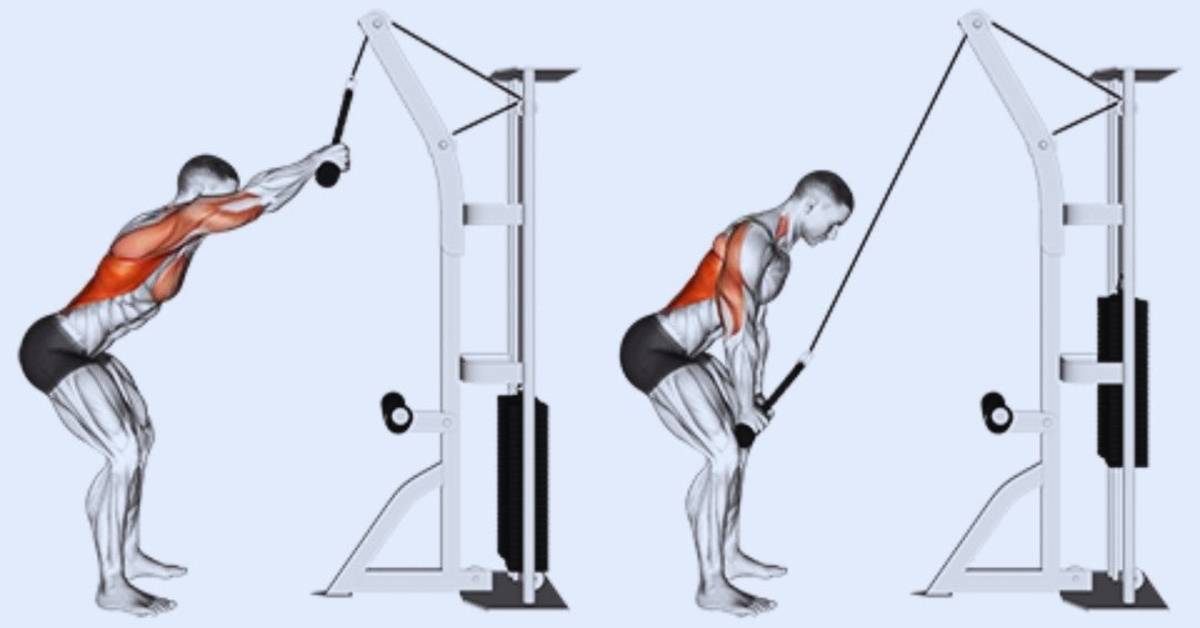The high to low cable fly is a highly effective strength training exercise that targets the chest muscles, specifically the pectoralis major. It is a popular exercise among fitness enthusiasts and bodybuilders due to its ability to isolate and develop the chest muscles. In this article, we will delve into the details of the high-to-low cable flys lower chest exercise, including how to perform it correctly, the muscles worked, essential tips, benefits, and variations to keep your workouts challenging and exciting.
Standing High to Low Cable Fly Muscles Worked
The Standing high-to-low cable flys also known as lower chest cable fly primarily target the chest muscles, specifically the pectoralis major. However, several other muscles are also engaged as secondary muscles during the movement. Let’s take a closer look at the muscles worked during the high-to-low flys:
Pectoralis Major
The pectoralis major is the main muscle targeted during the high to low cable fly exercise. It is a large, fan-shaped muscle that covers the upper part of the chest. This muscle is responsible for shoulder flexion, horizontal adduction, and internal rotation.
Pectoralis Minor
Situated beneath the pectoralis major, the pectoralis minor is a smaller muscle that aids in shoulder stabilization and protraction. While it is not directly targeted, it plays a supportive role during the exercise.
Anterior Deltoids
The anterior deltoids, or front deltoids, are located on the front part of the shoulder. These muscles assist in raising the arms during the high to low cable flies. They work together with the pectoralis major to perform the movement.
Biceps Brachii
The biceps brachii, commonly known as the biceps, are located on the front of the upper arm. Although the biceps are not the primary muscles involved in the high-to-low cable fly exercise, they act as stabilizers during the movement.
Serratus Anterior
The serratus anterior muscles are situated on the sides of the chest, extending from the ribs to the shoulder blades. These muscles assist in the protraction and stabilization of the scapulae during the exercise. They play a crucial role in maintaining proper shoulder mechanics and stability.
Rhomboids
The rhomboids are muscles located between the shoulder blades. Although not directly targeted during the high to low cable fly exercise, they help in shoulder retraction and stabilization. They work to keep the shoulder blades pulled back and down, aiding in proper form and posture.
Read Also: Pinch Press Exercise for Bigger Chest: How To, Muscles Worked, Benefits, Alternatives
How to Perform High to Low Cable for (Lower Chest) Correctly?
Performing the high to low cable fly exercise correctly is crucial to ensure maximum effectiveness and prevent injury. Follow these step-by-step instructions to perform the exercise with proper form:
- Set up the cable machine: Adjust the pulleys to the highest position and attach the stirrup handles to each side.
- Stand in the center: Position yourself between the pulleys, facing away from the machine, with your feet shoulder-width apart.
- Grab the handles: Reach up and grab the handles with an overhand grip, palms facing down. As you extend your arms out to the sides, they should be parallel to the ground.
- Assume a split stance: Take a step forward with one leg and slightly bend your knees. This position provides stability during the exercise.
- Engage your core: Keep your back straight, shoulders down and back, and engage your core muscles throughout the exercise. This helps maintain proper posture and stability.
- Initiate the movement: Start by bringing your hands together in front of your body, crossing them at the midline. Imagine hugging a large tree trunk. This movement should be performed in a slow and controlled manner, focusing on the contraction of your chest muscles.
- Squeeze your chest muscles: At the peak of the movement, when your hands are crossed in front of you, focus on squeezing your chest muscles. This contraction ensures optimal muscle activation.
- Return to the starting position: Slowly reverse the movement, bringing your arms back to the starting position with control. Keep tension in your chest muscles throughout the entire range of motion.
- Repeat: Perform the desired number of repetitions, aiming for a controlled and smooth motion. Focus on the mind-muscle connection, feeling the chest muscles working throughout each repetition.
Important Tips
- Start with light weights: If you are new to the exercise or still developing your strength, begin with lighter weights. Gradually increase the resistance as you become more comfortable and confident with the movement.
- Avoid using momentum: It’s important to perform the high to low cable fly exercise using controlled movements. Make sure you don’t swing the weights or use momentum when lifting them. This will ensure that the targeted muscles are properly engaged throughout the exercise.
- Breathe correctly: Inhale during the eccentric phase (returning to the starting position) and exhale during the concentric phase (bringing your hands together). Proper breathing technique helps maintain stability and focus during the exercise.
- Focus on the chest muscles: Concentrate on contracting and squeezing your chest muscles during the movement. Visualize the chest muscles doing the work, rather than relying solely on your arms or shoulders.
- Maintain proper posture: Keep your back straight, shoulders down and back, and core engaged throughout the exercise. Avoid slouching or hunching forward, as this can compromise the effectiveness of the exercise and increase the risk of injury.
Mistakes to Avoid While Performing High to Low Lowers Chest Cable Fly
While performing the high-to-low lower chest cable fly exercise, it’s important to be aware of common mistakes that can compromise its effectiveness and increase the risk of injury. Here are some key mistakes to avoid:
- Rounding the back: It’s essential to maintain a neutral spine and avoid rounding your back during the exercise. Rounding the back can place unnecessary stress on the spine and decrease the engagement of the chest muscles. Keep your back straight and shoulders down and back throughout the movement.
- Allowing the elbows to flare out: Letting your elbows flare out to the sides can shift the emphasis away from the chest muscles and place more stress on the shoulders. Keep your elbows slightly bent and maintain a controlled movement, focusing on bringing your hands together in front of your body.
- Not fully extending or squeezing at the peak: Failing to fully extend your arms at the starting position or not squeezing your chest muscles at the peak of the movement reduces the effectiveness of the exercise. Ensure that you fully extend your arms and actively squeeze your chest muscles at the peak contraction for optimal muscle activation.
- Holding your breath: It’s important to maintain proper breathing throughout the exercise. Avoid holding your breath, as it can lead to increased tension and compromise your form. Inhale during the eccentric phase (returning to the starting position) and exhale during the concentric phase (bringing your hands together).
- Rushing the repetitions: Performing the exercise in a rushed manner can lead to poor form and reduced muscle activation. Focus on performing each repetition with control and precision, emphasizing the mind-muscle connection.
- Neglecting warm-up and cool-down: Skipping a proper warm-up and cool-down can increase the risk of injury. Prior to starting the exercise, perform a dynamic warm-up to activate the muscles and increase blood flow. After completing the exercise, incorporate static stretching to help cool down the muscles and promote flexibility.
Benefits of Cable Flys High to Low
The cable fly high to low offers a range of benefits that make it a valuable addition to your workout routine. Let’s explore some of the key benefits:
- Targeted Chest Development: The primary benefit of the high to low cable fly is its ability to effectively target and develop the chest muscles, specifically the pectoralis major. By bringing your hands together in a controlled manner, you engage the chest muscles and promote their strength and growth.
- Muscle Isolation: Unlike compound exercises that involve multiple muscle groups, the high to low chest fly exercise allows for targeted isolation of the chest muscles. This isolation can help address muscle imbalances and ensure that the chest muscles are adequately stimulated for optimal development.
- Increased Range of Motion: The cable system provides constant tension throughout the exercise, allowing for a full range of motion. This increased range of motion helps to fully stretch and contract the chest muscles, promoting muscle growth, flexibility, and mobility.
- Improved Chest Definition: Regularly incorporating the high to low cable chest flys into your workout routine can contribute to improved chest definition. It helps develop the shape and size of the pectoralis major, resulting in a more defined and sculpted chest.
- Enhanced Upper Body Strength: As a compound movement targeting the chest muscles, the high to low cable fly exercise also engages secondary muscles such as the anterior deltoids, pectoralis minor, biceps brachii, serratus anterior, and rhomboids. This engagement leads to increased overall upper-body strength and stability.
- Functional Strength: The high to low cable fly exercise mimics movements involved in various daily activities and sports, such as pushing, lifting, and throwing. By strengthening the chest muscles and improving their functional capacity, you enhance your ability to perform these activities with greater ease and efficiency.
- Core Stabilization: Proper execution of the cable fly high to low requires maintaining a stable core and posture throughout the movement. This engages the core muscles, including the abdominals and lower back, resulting in improved core stability and overall body control.
- Versatility and Variation: The high to low cable fly exercise offers versatility in terms of variations and modifications. You can adjust the cable height, hand positioning, and grip to target different areas of the chest and challenge your muscles in various ways. This variety helps prevent boredom and plateaus, keeping your workouts exciting and effective.
- Improved Mind-Muscle Connection: Performing the high to low cable fly exercise with proper form and focus enhances the mind-muscle connection. This increased awareness and control allow you to better isolate and engage the chest muscles, maximizing their recruitment and development.
- Injury Prevention: Strengthening the chest muscles through exercises like the high to low cable fly can help prevent injuries and improve overall shoulder stability. By addressing muscle imbalances and strengthening the supporting muscles, you reduce the risk of shoulder and chest-related injuries.
High to Low Lower Chest Cable Fly Alternative
If you’re looking for alternatives to the high to low cable fly exercise, there are several exercises that target similar muscle groups and provide comparable benefits. Here are three effective alternatives:
Dumbbell Flyes:
Dumbbell flyes are a popular alternative that effectively target the chest muscles. Here’s how to perform them:
- Lie on a flat bench with a dumbbell in each hand, palms facing each other.
- Start with your arms extended above your chest, slightly bending your elbows.
- Lower the dumbbells in a controlled manner to the sides, keeping a slight bend in your elbows.
- Pause when you feel a stretch in your chest, then return to the starting position by squeezing your chest muscles.
- Focus on maintaining proper form, engaging the chest muscles, and avoiding excessive shoulder movement.
Decline Cable
Decline cable flyes can be considered a variation of the high to low cable fly exercise. While the high to low cable fly primarily targets the upper and middle chest muscles, decline cable flyes shift the emphasis to the lower portion of the chest.
To perform decline cable flyes:
- Set up the cable machine: Adjust the pulleys to the lowest position and attach the handles or stirrup handles.
- Position yourself on a decline bench: Lie down on a decline bench at an angle of approximately 30-45 degrees. Ensure that your head is positioned lower than your feet.
- Grab the handles: Reach up and grab the handles with an overhand grip, palms facing each other. Your arms should be extended out to the sides, slightly bent at the elbows.
- Engage your core and maintain stability: Keep your back pressed against the bench, shoulders down and back, and engage your core for stability throughout the exercise.
- Initiate the movement: Begin by bringing your hands together in front of your body, crossing them at the midline. Focus on a slow and controlled movement, feeling the contraction in your lower chest muscles.
- Squeeze your lower chest muscles: At the peak of the movement, when your hands are crossed in front of you, focus on squeezing your lower chest muscles to maximize muscle activation.
- Return to the starting position: Slowly reverse the movement, allowing your arms to move back out to the sides in a controlled manner. Maintain tension in your chest muscles throughout the entire range of motion.
- Repeat: Perform the desired number of repetitions, focusing on the mind-muscle connection and maintaining proper form.
Machine Pec Fly
Machine pec fly is a popular exercise that primarily targets the chest muscles, specifically the pectoralis major. It is performed using a machine designed specifically for this exercise, commonly found in gyms. Machine pec fly offers several benefits and is a great addition to your chest workout routine. Here’s how to perform the exercise:
- Adjust the machine: Set the seat height according to your comfort level so that the handles are positioned at chest height. Ensure that the machine’s arms are in line with your chest.
- Sit on the machine: Sit on the seat with your back against the backrest, and your feet firmly planted on the floor. Maintain a neutral spine and engage your core for stability.
- Grasp the handles: Reach out and grab the handles with an overhand grip, palms facing inward. Position your elbows at a 90-degree angle, parallel to the floor. This is your starting position.
- Initiate the movement: Exhale and push the handles forward, keeping a slight bend in your elbows. Allow your chest muscles to stretch as your arms move forward.
- Squeeze your chest muscles: Once your arms are fully extended in front of you, pause for a moment and focus on squeezing your chest muscles. Maintain tension in the chest muscles throughout this phase.
- Return to the starting position: Inhale and slowly reverse the movement, bringing your arms back to the starting position in a controlled manner. Keep the same slight bend in your elbows and avoid locking them.
- Repeat: Perform the desired number of repetitions, maintaining a smooth and controlled motion. Focus on the mind-muscle connection, feeling the chest muscles working throughout each repetition
Chest Dips
Chest dips, also known as parallel bar dips, are a challenging bodyweight exercise that primarily target the chest muscles, triceps, and shoulders. They can be performed on parallel bars or dip bars and offer a range of benefits. Here’s a guide on how to perform chest dips:
- Set up the bars: Position yourself between two parallel bars or dip bars. Make sure the bars are sturdy and securely fixed in place. Grip the bars firmly with your palms facing downward.
- Starting position: Lift yourself up, supporting your bodyweight with your arms fully extended. The distance between your arms should be slightly wider than the distance between your shoulders. For stability, you must keep your torso upright and engage your core as much as you can.
- Lowering phase: Inhale and slowly lower your body by bending your elbows. Lean forward slightly to put more emphasis on the chest muscles. Lower your body until your shoulders are slightly below your elbows or until you feel a stretch in your chest.
- Pushing phase: Exhale and push through your palms, extending your elbows to lift your body back to the starting position. Focus on contracting your chest muscles as you ascend. Keep your body stable and avoid excessive swinging or using momentum.
- Repeat: Perform the desired number of repetitions while maintaining control and proper form. If you’re a beginner, start with a lower number of reps and gradually increase as you build strength and confidence.
FAQs
Does low cable fly work upper or lower chest?
Low cable fly primarily targets the lower chest muscles.
Are high to low lower chest cable flys worth it?
Yes, high to low cable flys can be worth it as they target the lower chest muscles, providing a well-rounded development of the chest. They can help improve lower chest definition and contribute to overall chest symmetry.
What is the difference between high and low cable flyes?
The main difference between high and low cable flyes is the range of motion and the specific chest muscles targeted. High cable flyes involve bringing the cables from a high position down towards the chest, targeting the upper and middle chest muscles. Low cable flyes, on the other hand, start with the cables at a low position and involve lifting them up towards the chest, primarily targeting the lower chest muscles. Both variations offer unique benefits and can be incorporated into a well-rounded chest workout routine.
How often should I work my lower chest?
To effectively work your lower chest muscles, it is recommended to include lower chest exercises in your workout routine 1-2 times per week. Allow for adequate rest and recovery between sessions to avoid overtraining and promote muscle growth. Adjust the frequency based on individual needs and goals.









